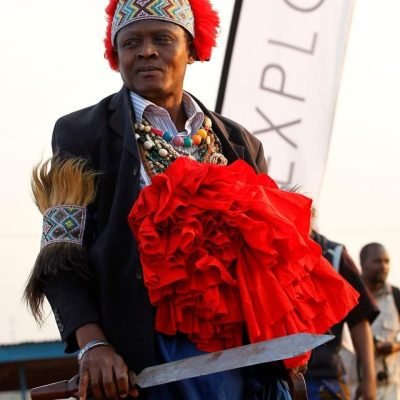Kuomboka Ceremony
" to get out of water "
- Ruled by: The Litunga
- Tribe: Lozi
- Domain: Barotseland

- Purpose: Flood migration
- From: March
- Location(s): Lealui to Limulunga
- District(s): Mongu
- Province: Western Province
Share:
General Information
The Kuomboka ceremony is one of Zambia’s biggest traditional events. It takes place every year at the end each rainy season, when the upper Zambezi River floods the plains of the Western Province. The festival celebrates the move of the Litunga, king of the Lozi people, from his compound at Lealui in the Barotse Floodplain of the Zambezi River to Limulunga on higher ground.
History
Historians claim that before the time of the first known male Lozi chief Mboo, there came a great flood called Meyi-a-Lungwangwa meaning “the waters that swallowed everything.” The vast plain was covered in the deluge, all animals died and every farm was swept away.
People were afraid to escape the flood in their little dugout canoes. So it was that the high god, Nyambe, ordered a man called Nakambela to build the first great canoe, Nalikwanda, which means “for the people,” to escape the flood. Thus the start of what is known today as the Kuomboka ceremony.
Procession
The ceremony begins with two white scout canoes that are sent to check the depth of the water and for the presence of any enemies. Once the scouts signal the “all clear”, the journey to the highland begins.
The journey to Limulunga normally takes about 6–8 hours. The Litunga is accompanied on the journey by his local area chiefs known as the Indunas.
The King’s state barge is called Nalikwanda and is painted black and white, like Zambia’s coat of arms. On the barge is a replica of a huge black elephant, the ears of which can be moved from inside the barge. There is also a fire on board, the smoke from which tells the people that the king is alive and well. The Nalikwanda is large enough to carry his possessions, his attendants, his musicians, his 100 paddlers. It is considered a great honour to be one of the hundred or so paddlers on the nalikwanda and each paddler wears a headdress of a scarlet beret with a piece of a lion’s mane and a knee-length skirt of animal skins.
For his wife there is a second barge. This one has a huge cattle egret (Nalwange) on top. The wings move like the ears of the elephant, up and down.
The return trip is usually held in August with a less publicized journey called the Kufuluhela
Dress
The Litunga begins the day in traditional dress, but during the journey changes into the full uniform of a British admiral that was presented to the Litunga in 1902 by King Edward VII, in recognition of treaties signed between the Lozi people and Queen Victoria.
Each paddler wears a headdress of a scarlet beret with a piece of a lion’s mane and a knee-length skirt of animal skins.
The traditional dress worn by the Lozi women is called the Musisi. It is a beautiful and symbolic piece of their cultural identity. The Musisi is a wraparound dress, typically made from brightly colored cotton fabric with intricate patterns. The colors and patterns of the Musisi can vary, but some common colors include red, blue, green, and yellow. The patterns often hold symbolic meanings. It can be further adorned with beads, shells, and other embellishments.
The Musisi is not just clothing; it holds cultural significance. It’s often worn for special occasions like weddings, ceremonies, and cultural celebrations.
The men wear an outfit known as a Siziba. It is a two-piece outfit consisting of a long loincloth and a short tunic or shirt.
Traditionally, the Siziba was made from animal skins, but nowadays, cotton fabric is more commonly used and can be decorated with beads, shells, and fringes, similar to the Musisi worn by women.
Like the Musisi, the Siziba is worn for special occasions and cultural events, representing pride in Lozi heritage.
Musical Instruments
The ceremony is preceded by heavy drumming of the royal Maoma drums, which echoes around the royal capital the day before Kuomboka, announcing the event.
Drums beat throughout to coordinate and energise those paddling the barge. The most important are the three royal war drums – kanaona, munanga, and mundili – each more than one metre wide and said to be at least 170 years old.
No donation to this project yet.
| M | T | W | T | F | S | S |
|---|---|---|---|---|---|---|
| 1 | 2 | |||||
| 3 | 4 | 5 | 6 | 7 | 8 | 9 |
| 10 | 11 | 12 | 13 | 14 | 15 | 16 |
| 17 | 18 | 19 | 20 | 21 | 22 | 23 |
| 24 | 25 | 26 | 27 | 28 | ||







